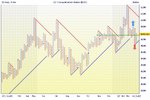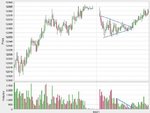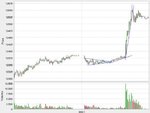bluetipex
Active member
- Messages
- 174
- Likes
- 22
You're all going to despise me.
I freely admit that you're all talking a langauge that I don't understand. I suspect that others reading this thread may also be in the same boat. However, I am intrigued and curious.
I day trade for a living.
I have no other form of income.
I spread bet.
I use (lagging) indicators.
I watch Dax and Dow only. Nothing else.
I have volume on my charts but I don't know how to use it. Sometimes, when I see a rally, and then I get a large volume bar, and then price either stops or retraces, I suspect that that is "stopping volume", i.e. that that bar comprised mostly sellers stopping the price go any higher. However, I don't make any trading decisions based on volume. My trading decisions are based solely on my indicators, and my "feel" for the market, which i have watched for many, many, many days, weeks, and months. All day. Every day. I am aware when my indicators are valid, and when they should be ignored. When they should be ignored I mentally remove them from my chart. E.g. when the market is in a steep trend any momentum indicator should be ignored.
Now, a fact that I'm sure, we will all agree upon, is that the BEST indicator of all is..... PRICE.
Where we differ is the method that we use to predict where PRICE will most likely go in the coming bar(s).
I will consult with the glossary of terms on T2W, because you're using terminology which is alien to me. I hope this thread continues, because, one day, when I understand what you're actually talking about, I may come back to it, and it will enhance my trading ability. Until then I will continue to "lurk" and stand on the sidelines.
Let the abuse commence.
I freely admit that you're all talking a langauge that I don't understand. I suspect that others reading this thread may also be in the same boat. However, I am intrigued and curious.
I day trade for a living.
I have no other form of income.
I spread bet.
I use (lagging) indicators.
I watch Dax and Dow only. Nothing else.
I have volume on my charts but I don't know how to use it. Sometimes, when I see a rally, and then I get a large volume bar, and then price either stops or retraces, I suspect that that is "stopping volume", i.e. that that bar comprised mostly sellers stopping the price go any higher. However, I don't make any trading decisions based on volume. My trading decisions are based solely on my indicators, and my "feel" for the market, which i have watched for many, many, many days, weeks, and months. All day. Every day. I am aware when my indicators are valid, and when they should be ignored. When they should be ignored I mentally remove them from my chart. E.g. when the market is in a steep trend any momentum indicator should be ignored.
Now, a fact that I'm sure, we will all agree upon, is that the BEST indicator of all is..... PRICE.
Where we differ is the method that we use to predict where PRICE will most likely go in the coming bar(s).
I will consult with the glossary of terms on T2W, because you're using terminology which is alien to me. I hope this thread continues, because, one day, when I understand what you're actually talking about, I may come back to it, and it will enhance my trading ability. Until then I will continue to "lurk" and stand on the sidelines.
Let the abuse commence.



